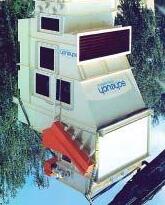MATERIAL SEPARATION USING AIR: CLASSIFIER SYSTEMS FOR A VARIETY OF APPLICATIONS


If the components that must be separated have different densities, particle sizes or particle shapes, and consequently different settling speeds in air, classifier systems that use air to achieve material separation lend themselves to the sorting process.
tions and ensures the high quality of the MDF sheets, which is especially important in the case of thin sheets.
In this system, the fibres are loaded into the classifying room and are subsequently captured by a lateral stream of air that is directed upwards. A second stream of air from below counteracts the downward movement of the fibres and builds a curtain of air. Only those particles with a settling speed higher than that of the rising air stream fall downward. These coarse materials would have caused quality problems during the MDF production process. The fibres themselves — with a lower settling speed — are carried away by the air stream and removed via the classifier’s discharge opening.
Scheuch first turned its attention to the topic of airstream sorting some 10 years ago and developed the SWSF fibre classifier (SWSF = Scheuch-Wind-Sichter für Fasern) for use in the production of MDF board. Its job is to clas-
Scheuch has installed nearly 100 of these plants since 1995 — 75% of which have been installed in Europe.
Scheuch offers two proven classifier versions for classifying materials in the recycling sector
specific heavy materials (the heavy fraction) settle downward, whereby the air velocity employed is used to define the materials that are to be discharged. The light fraction (e.g., foil, paper, fibres, wires, etc.) is carried up and away by the air stream.

For applications involving the classification of finer materials, where more precise separation is required, Scheuch implemented the principle of up-current classification in a zigzag classifier. Because of the zigzag shape of the upcurrent ductwork, the coarse material that slides down the slanted walls is repeatedly fed diagonally through the air stream and “reclassified”. The circulating air currents that build in the corners of the ductwork also provide for good dispersing of the feed material and cause additional re-classifying effects.
Scheuch developed the cascading classifier especially for applications requiring the removal of filler material in the gravel and crushed stone industries. In this method, the separation process takes place in two stages: The sand classifier is fed from above with material, which then flows downward over several cascades. The air required for the classification process is drawn in from below and is then blown crossflow and at high speeds through the material by the cascades, which function here as nozzles. This creates high shearing forces that separate ultra-fine grains from coarse grains. It is important for subsequent gravity separation to achieve a uniform up-current flow. In this process, coarse-grained material falls down and out of the classifier, while ultra-fine material is carried upward by the air stream and then out of the classifier for separation in a dedusting plant.
All of Scheuch’s classifier versions at a glance:
3
4
sify and remove from amongst the fibres such coarse materials as fibre balls and clumps, or foreign matter such as metal or rubber particles. This eliminates material-related malfunc-
(e.g., building rubble and waste). One of these, the fall shaft classifier — also called an upcurrent classifier — is used to classify coarse materials. In this variant, compact, coarse and


1
2
Fibre classifier SWSF for MDF board production Fall shaft classifier Zigzag classifier for material classification
Cascaded classifier for removing filler material
Scheuch sand classifiers offer outstanding separation performance with adjustable filler removal, e.g., from 25% filler proportion to about 5 percent.

